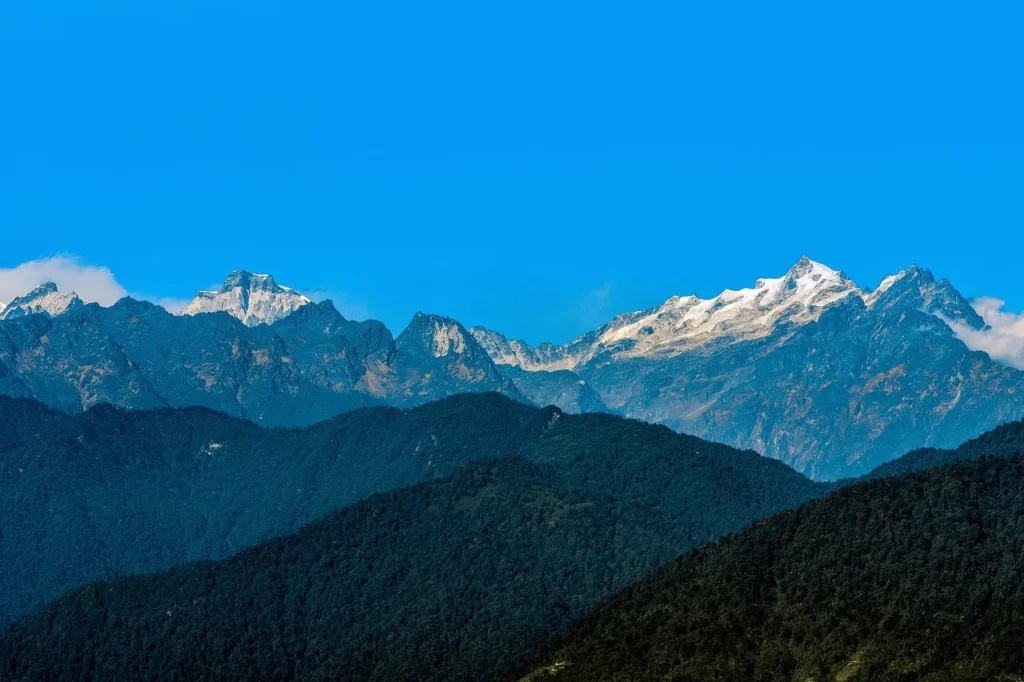Mount Kailash is a holy place to the Hindus, Buddhists, Jains, and the Bon. Travelers have options for the Kailash Mansarovar Yatra routes according to their desires.
Hindus believe that it is the dwelling place of Lord Shiva and Buddhists believe that it is the dwelling place of a personification of supreme bliss called Demchok. Nationals of different countries visit to find peace and blessings in the spiritual world.
Routes to Kailash Mansarovar Yatra from Nepal
Nepal is an extremely frequented approach to Mount Kailash Yatra. The trip will not be only spiritual because in Nepal you will witness incredible natural landscapes, mountains, and feel the intense local culture of the nation.
1. Kodari Zhangmu (Historical Route)
Kodari-Zhangmu is the route that has been used extensively as a trade route between Nepal and Tibet.
It begins with a small town in the Arniko Highway east of Kathmandu, which is called Kodari.
The traveled roads culminate in Zhangmu which is a Tibetan border town.
The trade route which was part of the old Silk Road for many centuries. Through the Bhote Koshi river valley travelers pass over suspension bridges and through forested hills.
At times they stay in small villages and seek accommodation in Tibetan monasteries.
Pilgrims can see the Langtang and Rolwaling ranges from a distance. The route also provides a mix of culture and nature. Due to the 2015 Earthquake, roads and bridges were very damaged.
Presently, the Kodari Zhangmu route is closed to tourists. It is of historical importance which is still true but for Kailash pilgrimages, it is no longer in use.
2. Rasuwa-Gyirong (Present Primary Overland Route)
The Rasuwa–Gyirong route is the primary route for Kailash Yatra from Nepal. It begins in Kathmandu which is also the point pilgrims get their travel permits and health clearances. From Kathmandu they head north via the Araniko Highway.
The road that goes through Dhunche and Rasuwagadhi which have guest houses and local shops. Travelers pass by rivers, valleys, and terraced fields. The setting is very peaceful and green.
At Gyirong the border crossing takes place. Here authorities check documents and permit. Once in Tibet the road is paved which takes us to Saga and Purang.

Travelers head to Manasarovar Lake which is the most sacred in the world. The trip takes 7-9 days which may vary with stops. Pilgrims gradually acclimatize to high altitudes.
This is a smooth, secure and easy-going Kailash Mansarovar Yatra Route which also puts you in touch with culture, landscapes and the spiritual.
3. Kailash Yatra from Simikot- Hilsa Route
The Simikot-Hilsa route may be a less-beaten track but very much an adventure. From the capital, Katmandu, a flight will take you to Nepalgunj then to Simikot in the mid-west of the country.
Then, one needs to take a Helicopter from Simikot to Hilsa. From Hilsa pilgrims go to Tibet and out to Purang. It takes them to Darchen the base for Mount Kailash.
This route is of 12 to 15 days duration which is a longer time than that of the Rasuwa–Gyirong route.
The road at times is rough. Pilgrims pass through remote villages, rivers, forests, and high passes. This Kailash Mansarovar Yatra Route is quiet which in turn gives a true adventure experience. Pilgrims should expect of limited services and variable weather.
4. Helicopter Option: Kathmandu – Hilsa – Kailash
The Kailash Heli tour is for those pilgrims short on time or that prefer comfort. At the Kathmandu airport we begin to fly for Nepalgunj.
Helicopters touch down at Hilsa at times near Manasarovar Lake. From there a short drive takes pilgrims to Darchen.
This option plays out over the space of 5 -7 days. Pilgrims report that they see Mount Kailash and the surrounding lakes from above which is a very breathtaking experience. It is quick, scenic, and luxurious but also expensive.
Kailash Mansarovar Yatra Routes from India
India has put in place organized pilgrimage itineraries to Mount Kailash that are run by the government for your safety and convenience. We take you through the great Himalayan range which also provides spiritual fulfillment and spectacular scenery.
1. Lipulekh Pass (route in Uttarakhand)
The Lipulekh Pass- Kailash route begins at Delhi. Pilgrims travel by road to Tanakpur which is a small town in Uttarakhand. From there the journey goes on via bus or jeep through Pithorgarh and local villages.
As travelers approach Lipulekh Pass, which is the Himalayan border between India and Tibet, the road goes up into the mountains. At the pass pilgrims cross over into Tibet and head for Purang and Darchen which serve as the foot of Mount Kailash.
The journey is for a duration of 23 days. This route is organized by the government which in turn provides guides, vehicles and accommodation. It is a well-thought-out and safe route which is recommended for first time pilgrims.
Along our journey we pass by snowcapped peaks, rivers, and small Himalayan villages. The route is also very spiritual as we come close to Adi Kailash which is a sacred mountain.
2. Nathu La Pass (in Sikkim)
In Gangtok, the capital of Sikkim the Nathu La Pass route starts. Pilgrims travel by road through towns like Rangpo and Sherathang.
At that high altitude the pass is located which provides great views of the Himalayas and glacial valleys.

After crossing the border into Tibet, we head out on the highways to Purang and then Darchen.
This route which is of 25 days duration also has a government organization with only a few permits issued out each year. Along the way pilgrims experience Tibetan culture, mountain scenery, and local monasteries.
3. Indian Kailash Yatra through Nepal
Some Indian tourists choose the Nepal entry point into Tibet. This route from Kathmandu uses either the Rasuwa–Gyirong or Hilsa routes.
From Kathmandu, pilgrims head into Tibet and out to Manasarovar Lake and Darchen. This is a flexible route which also allows visitors to combine in with cultural sightseeing in Nepal before or during the Kailash Yatra.
It’s a choice for the adventurous or for those which prefer a longer spiritual journey. Travel time will vary by route and stop.
Learn more about the resumption of the Kailash Yatra for Indian Citizens.
Kailash Mansarovar Yatra Routes from Tibet
Tibet is home to the closest you will get to Mount Kailash. There are majorly two famous routes for Kailash Yatra from Tibet.
1. Kailash Mansarovar Yatra route via Lhasa
The Lhasa to Kailash Tour begins in Lhasa, which is the Tibetan capital. The first attraction of the pilgrims is the Potala Palace and other cultural sites. Thence they head southwestward along the Lhasa-Shigatse Highway.
The highway leads them across Gyantse with a historic monastery and fortress. They proceed to Saga, which is a tiny town on the Tibetan plateau and go by rivers, elevated plains, and isolated villages.
The pilgrims pass Saga, across the Nepal border, then to Purang, and then on to Darchen, the foot of the mountain Kailash. The journey covers holy lakes, including Manasarovar and Rakshastal which are very spiritual.

The whole trek normally takes 13-15 days where it is possible to do sightseeing and get used to the environment. It is neatly arranged, picturesque and perfect to first time visitors to Tibet.
2. Kailash Yatra via Ali on Northern Passage
The mountain path being discussed originates at Ali, a very isolated town in western Tibet. Tourists pass through desert-like areas, over small villages, and a sparsely populated highland.
Pilgrims arrive at Ali and then to Purang and later to Darchen. This is the little-used road that provides another view of Mount Kailash.
The trip is not easy; the roads are mostly in a bad condition and facilities are few. The pilgrims must be physically fit and also used to the altitude.
The north pathway is favored by the adventure tourists who want seclusion.
3. Kailash Kora: The Sacred Circuit
Kailash Parikrama begins at 52 km at Darchen, and is a pilgrimage to Mount Kailash.
- Direction: Hindus are clockwise whereas Bon followers are anticlockwise.
- Duration: It normally takes three days.
- Highlights: The walk will take through high passes such as Dolma La and will be a panoramic view of great landscapes, prayer flags, and old monasteries
- Spiritual meaning: The completion of the Kora is said to be a blessing, with sin being removed.
Conclusion: Select Your Kailash Mansarovar Yatra Route
The pilgrimage to Mount Kailash is a once-in-a-lifetime experience. In Nepal we have best routes for first-time pilgrims.
These are beautiful, safe, and comfortable options which also include the choice of a helicopter for a faster trip.
India’s routes which are very structured and have support from the government. They may be a bit longer but, in that time, travelers have the chance to see the beautiful Himalayan landscapes and experience sacred sites like Adi Kailash.
Tibetan routes for the adventurous and the spiritual are second to none. We have high altitude plains, great landscapes and the option of a stop at the Everest Base Camp.
They do require you to be in good fit health and do proper preparation, but the rewards are memories that last a lifetime.
No matter your choice of path the journey to Mount Kailash is of faith and adventure which also includes the spectacular beauty of the Himalayas, which in turn makes it a once-in-a-lifetime experience.
Send an Enquiry
Error: Contact form not found.
© 2025 - Himalayan Trekking and Tours (P) Ltd. All Rights Reserved.

